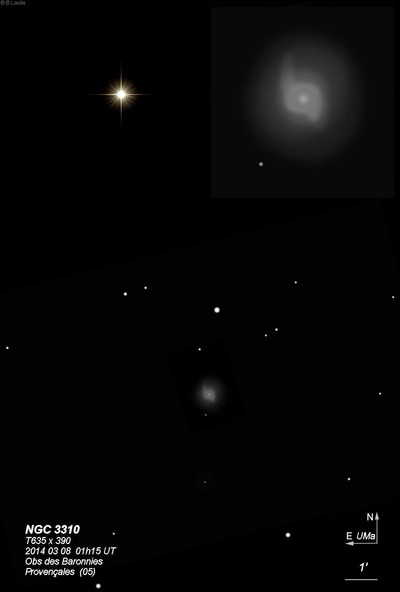
William Herschel discovered NGC 3310 = H IV-60 = h731 on 12 Apr 1789 (sweep 919) and recorded "vB, R, planetary, but very ill-defined. About 1' dia of it is equally bright, and 1/4 of a minute hazy or ill-defined round the margin." His position is accurate. On 10 Feb 1831 (sweep 324), John Herschel wrote, "B; R; vsmbM, so as to for almost a disc 15" diam. Surrounded by a very feeble atmosphere."
On 5 Mar 1848, Lord Rosse and William Rambaut observed NGC 3310 (the earliest observation in LdR's 1861 monograph) and reported, "See minute points in it at intervals, also spiral arrangement well seen." Their 11 Mar observation states, "Nebula well resolved into little stellar points. Saw a broad band across the bottom distinctly and two at the top." NGC 3310 was included in the list of nebulae exhibiting spiral structure. Later observations mentioned the possibility of this object being a cluster. A detailed observation was made on 20 Feb 1868: "Three principal branches f, nf and np towards a * np [probably a HII region]. Dark cavity on nf side. Mr De la Rue, who was with me, saw it as a bay between 2 horns, and much neby surrounding it, with many stars exterior and involved.”
400/500mm - 17.5" (1/19/91): very bright, moderately large. Unusual appearance as contains a very bright, very large central core with uniform high surface brightness with only a very faint, fairly small halo, elongated NW-SE. Located 10.4' SSW of mag 5.5 HR 4165 at the edge of the 220x field. A mag 12 star lies 3.0' N.
900/1200mm - 48" (5/16/12): extremely bright, fairly large, sharply concentrated with a large, very bright, slightly elongated N-S core, ~1' diameter. The core appears mottled with a couple of "stellarings" or small knots. The core is surrounded by a larger, much lower surface brightness irregular halo, extending the central portion to nearly 2'. An outer spiral arm is attached on the north side of the halo and was most evident near the halo. Occasionally, a very large, very low surface brightness looping arm was glimpsed, rotating 180° clockwise and ending west of the core, ~1.7' from center.
Notes by Steve Gottlieb